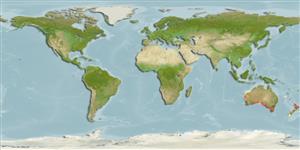Environment: milieu / climate zone / depth range / distribution range
Ecología
marino; rango de profundidad 5 - 65 m (Ref. 9563). Temperate
Eastern Indian Ocean: endemic to southern Australia (including New South Wales).
Tamaño / Peso / Age
Maturity: Lm ? range ? - ? cm
Max length : 84.0 cm TL macho / no sexado; (Ref. 9563)
A schooling species found in bays over rocky reefs (Ref. 9563).
Life cycle and mating behavior
Madurez | Reproducción | Puesta | Huevos | Fecundidad | Larva
Nelson, J.S., 1984. Fishes of the world. 2nd edition. John Wiley & Sons, Inc., New York. 523 p. (Ref. 245)
IUCN Red List Status (Ref. 130435)
Threat to humans
Harmless
Human uses
Más información
Nombres comunesSinónimosMetabolismoDespredadoresEcotoxicologíaReproducciónMadurezPuestaAgregación para la puestaFecundidadHuevosEgg development
Age/SizeCrecimientoLength-weightLength-lengthLength-frequenciesMorfometríaMorfologíaLarvaDinámica larvariaReclutamientoAbundanciaBRUVS
ReferenciasAcuiculturaPerfil de acuiculturaRazasGenéticaElectrophoresesheritabilidadEnfermedadesProcesamientoNutrientsMass conversion
ColaboradoresImágenesStamps, Coins Misc.SonidosCiguateraVelocidadTipo de nataciónSuperficie branquialOtolitosCerebrosVisión
Herramientas
Special reports
Download XML
Fuentes de Internet
Estimates based on models
Preferred temperature (Ref.
123201): 15.1 - 22.7, mean 17.8 °C (based on 174 cells).
Phylogenetic diversity index (Ref.
82804): PD
50 = 1.5000 [Uniqueness, from 0.5 = low to 2.0 = high].
Bayesian length-weight: a=0.00389 (0.00180 - 0.00842), b=3.12 (2.94 - 3.30), in cm total length, based on all LWR estimates for this body shape (Ref.
93245).
Nivel trófico (Ref.
69278): 3.7 ±0.5 se; based on size and trophs of closest relatives
Fishing Vulnerability (Ref.
59153): Moderate to high vulnerability (54 of 100).
Nutrients (Ref.
124155): Calcium = 37.9 [18.6, 65.7] mg/100g; Iron = 0.494 [0.276, 0.826] mg/100g; Protein = 18.4 [17.3, 19.4] %; Omega3 = 0.34 [0.18, 0.66] g/100g; Selenium = 15.3 [7.2, 31.6] μg/100g; VitaminA = 10.4 [2.9, 39.4] μg/100g; Zinc = 0.575 [0.400, 0.820] mg/100g (wet weight);
